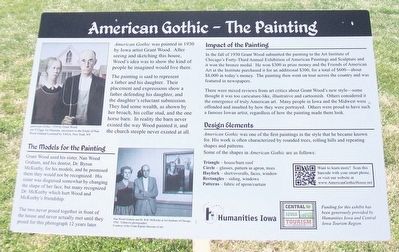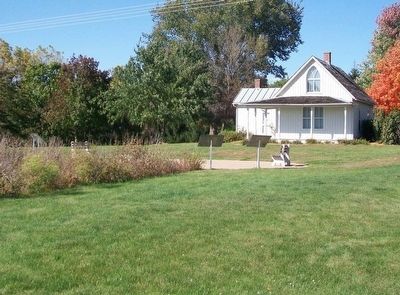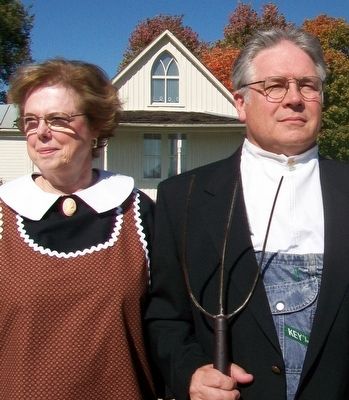American Gothic - The Painting
American Gothic was painted in 1930 by Iowa artist Grant Wood. After seeing and sketching this house, Wood's idea was to show the kind of people he imagined would live there.
The painting is said to represent a father and his daughter. Their placement and expressions show a father defending his daughter, and the daughter's reluctant submission. They had some wealth, as shown by her broach, his collar stud, and the one horse barn. In reality the barn never existed the way Wood painted it, and the church steeple never existed at all.
The Models for the Painting
Grant Wood used his sister, Nan Wood Graham, and his dentist, Dr. Byron McKeeby, for his models, and he promised them they would not be recognized. His sister was disguised somewhat by changing the shape of her face, but many recognized Dr. McKeeby which hurt Wood and McKeeby's friendship.
The two never posed together in front of the house and never actually met until they posed for this photograph 12 years later.
Impact of the Painting
In the fall of 1930 Grant Wood submitted the painting to the Art Institute of Chicago's Forty-Third Annual Exhibition of American Paintings and Sculpture and it won the bronze medal. He won $300 in prize money and the Friends of American Art at the Institute purchased it for an additional
There were mixed reviews from art critics about Grant Wood's new style - some thought it was too caricature-like, illustrative and cartoonish. Others considered it the emergence of truly American art. Many people in Iowa and the Midwest were offended and insulted by how they were portrayed. Others were proud to have such a famous Iowan artist, regardless of how the painting made them look.
Design Elements
American Gothic was one of the first paintings in the style that he became known for. His work is often characterized by rounded trees, rolling hills and repeating shapes and patterns.
Some of the shapes in American Gothic are as follows:
Triangle - house/barn roof
Circle - glasses, pattern in apron, trees
Hayfork - shirt/overalls, faces, window
Rectangles - siding, windows
Patterns - fabric of apron/curtain
Erected by American Gothic House Center, Humanities Iowa and Central Iowa Tourism Region.
Topics. This historical marker is listed in this topic list: Arts, Letters, Music. A significant historical year for this entry is 1930.
Location. 40° 55.278′ N, 92° 12.83′
Other nearby markers. At least 8 other markers are within walking distance of this marker. Grant Wood's Impact (here, next to this marker); The Artist, Grant Wood (here, next to this marker); The American Gothic House (here, next to this marker); Veterans Memorial (approx. half a mile away); McHaffey Opera House (approx. half a mile away); Doodlebug (approx. half a mile away); Charles M. Martin (approx. half a mile away); Gerald W. Fackler (approx. half a mile away). Touch for a list and map of all markers in Eldon.
Regarding American Gothic - The Painting. The painting is the second most parodied painting after the Mona Lisa.
Also see . . .
1. American Gothic at Art Institute of Chicago. (Submitted on November 6, 2015, by William Fischer, Jr. of Scranton, Pennsylvania.)
2. American Gothic House Center, Eldon, Iowa. (Submitted on November 6, 2015, by William Fischer, Jr. of Scranton, Pennsylvania.)
Credits. This page was last revised on June 16, 2016. It was originally submitted on November 5, 2015, by William Fischer, Jr. of Scranton, Pennsylvania. This page has been viewed 408 times since then and 32 times this year. Photos: 1. submitted on November 6, 2015, by William Fischer, Jr. of Scranton, Pennsylvania. 2. submitted on November 5, 2015, by William Fischer, Jr. of Scranton, Pennsylvania. 3. submitted on November 6, 2015, by William Fischer, Jr. of Scranton, Pennsylvania.


